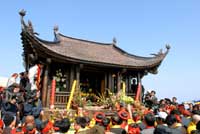Search Buddhist Channel
Reborn Pagoda Draws Buddhist Pilgrims
By Hong Minh, Vietnam News/ANN, Feb 6, 2007
Hanoi, Vietnam -- "In the mind of most Vietnamese Buddhists, Dong (Bronze) Pagoda is so sacred that it is a religious duty to visit it," said Pham Thanh Thuy, a faithful follower who witnessed the newly-restored pagoda's opening ceremony.
 Despite the night's biting cold at the top of the mountain amid Yen Tu's relic site, Thuy and 30,000 other Buddhists and pilgrims arrived a day ahead of the ceremony to pray.
Despite the night's biting cold at the top of the mountain amid Yen Tu's relic site, Thuy and 30,000 other Buddhists and pilgrims arrived a day ahead of the ceremony to pray.
"I have been waiting for years to witness such an imposing ceremony," she said. "Now that the pagoda has opened, the wishes of Buddhist followers in Vietnam to sincerely pray for the Buddha and fulfill their religious duty has been fulfilled."
When the 2,000-metre red cloth covering the entire pagoda came down, Thuy and others began to pray in two ceremonies, called ho than nhap tuong (invoking spirits to enter statues) and khai quang yen vi (sanctifying the Buddhist statue).
Master of Buddhism, Venerable Thich Thanh Quyet, spoke at the opening ceremony about the construction of the new Dong Pagoda, calling it the convergence of clement weather, favourable terrain and unity among the people.
The venerable, who also took charge on the construction, explained that during the last 15 months of work, the weather proved kind to builders.
"There is no winter rain in Yen Tu as usual this year," he said. "On the day we roofed the pagoda (in January), it was so bright that people could see the pagoda from a distance.
"As for favourable terrain, Yen Tu has been considered the holy land of the country with many eminent monk visitors who contribute a lot to the spiritual life and religion."
He added that the pagoda's building was a group effort, with help from the executive board of Quang Ninh provincial Buddhist church, Buddhists and donors nationwide.
"We are so happy that many people both at home and abroad have shared the burden, and now the joy, with us."
The Pagoda's History
Perched atop of Yen Tu Mountain--an important Buddhist pilgrimage destination since the 10th century--Dong Pagoda is the zenith among dozens of pagodas, shrines and towers in the Yen Tu's relic site in the northern province of Quang Ninh's Uong Bi Township. It stands at a height of 1,068m above sea level, making it the highest mountain top in the northeast region.
Buddhist history recounts that, at the end of the 13th century, after defeating Mongol invaders, King Tran Nhan Tong abdicated the throne in favour of his son Tran Anh Tong and moved to Yen Tu to practise a religious life.
Legend has it that hundreds of imperial concubines followed the king to persuade him to abandon the idea, but failed in their attempt.
At the shelter the king founded the Truc Lam (Bamboo Forest) Zen Buddhist sect. Sacred Yen Tu Mountain then became the ancestral land of Vietnamese Buddhism.
Built during the Le dynasty (1428-1527), Dong Pagoda's name implies joined hearts, minds and power. It represents the victory of King Tran Nhan Tong and his people over foreign invaders and the move towards a unified society.
Initially, it was nothing more than a small bronze temple at the peak of Yen Tu Mountain, but in 1740 the pagoda was destroyed by storms. It wasn't until 1930 that new cement was laid on the old foundation.
In 1993, another small bronze pagoda was built next to the cement one. Pilgrims, at that time, prayed at both pagodas on one peak.
New And Improved
Determined to help pilgrims be more comfortable when worshipping the Buddha, the Quang Ninh provincial People's Committee decided to build Dong Pagoda, merging the two older constructions into one new one.
Under the project, a new bronze pagoda covering 20 sq m and weighing up to 70 tonnes was recast. Its architecture adheres to the style of the Tran dynasty, from ornamentation to the height and length.
Venerable Thich Thanh Quyet said stones holding up the two old pagodas would be untouched, because each of them was sacred. The stone foundation was consolidated by steel piles and reinforced with concrete underneath to hold the weight of the new pagoda.
The committee selected the Hanoi Fine Arts Construction Company for the job. The company's director, Pham Thi Mai Hoa, said the biggest obstacle was logistics--transporting heavy stone up a 3,500-metre pathway to the mountain's peak 1,068m above sea level.
"At first, we thought about using a capstan by installing six pillars along the way from Giai Oan to transport materials and cast parts upwards," Hoa said. "This way would require careful work, as any negligence may result in scratches on cast products.
"Finally, we decided to use a cable car."
Each piece of the bronze pagoda was carried to the peak, where it was assembled.
Other auxiliary works, including the stone staircase leading to the pagoda and its backyard for worship activities, were also upgraded.
Do Quang Vinh, a Buddhist from Hanoi, said, "Whenever I reach Dong Pagoda, I always feel peaceful, as all my pains and troubles are released. On bright days you can see the entire province, and on foggy days, you feel like you're bobbing on a cloud."
Please support to keep NORBU going:
For Malaysians and Singaporeans, please make your donation to the following account:
Account Name: Bodhi Vision
Account No:. 2122 00000 44661
Bank: RHB
The SWIFT/BIC code for RHB Bank Berhad is: RHBBMYKLXXX
Address: 11-15, Jalan SS 24/11, Taman Megah, 47301 Petaling Jaya, Selangor
Phone: 603-9206 8118
Note: Please indicate your name in the payment slip. Thank you.
We express our deep gratitude for the support and generosity.
If you have any enquiries, please write to: editor@buddhistchannel.tv

